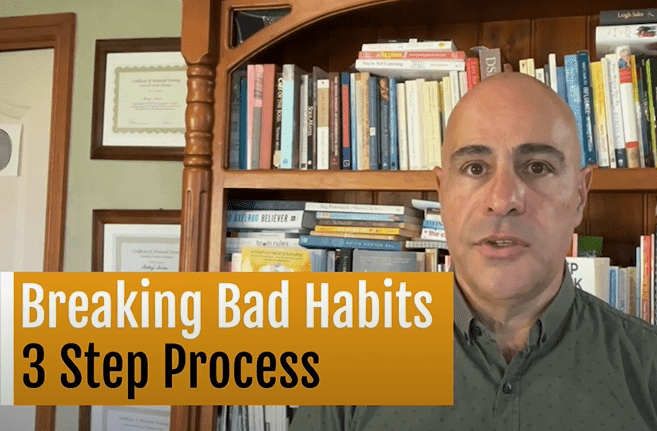After reading Dr. Jud Brewer’s excellent book Unwinding Anxiety I started researching more of his work find him at https://drjud.com/ and came across this really simple framework around breaking bad habits.
It explains how our brains learn in a simple, three-step process called “reward-based learning” — a process that’s easily illustrated with food:
- We see some food that looks good, and our brain says: Calories! Survival!
- We eat the food. It tastes great!
- Our body sends a signal to our brains: remember what you are eating and where you found it.
We lay down what’s called a “context-dependent memory,” and we learn to repeat the process next time. See food, eat food, feel good. Repeat.
Trigger, behaviour, reward. Those three things:
Trigger
Behaviour
Reward is how we create habits.
After a while, our brains connect any time you feel bad, just eat something good and you’ll feel better!
We thank our brains for that great idea, and quickly learn that it’s true: if we eat chocolate or ice cream when we’re mad or sad, we do feel better.
In the modern world, however, we feel bad for many different reasons.
Conflict at work? Stuck in traffic? Just broke up with your significant other? Mad at something you saw on the news?
Our bodies are constantly reacting to the world around us — creating sensations and emotions that often we’re not consciously aware of, but that still make us uncomfortable.
When that happens, our brain jumps in and tries to “fix” it for us. It looks for anything that has made us feel better in the past, and says “Do that!”
Food is the easiest example, but in the modern world, there are plenty of “feel good” experiences right at our fingertips, like checking social media, online shopping, watching cute kitten videos on YouTube… you name it.
All of these things distract us from the uncomfortable sensations with a small burst of the “happiness” neurotransmitter dopamine.
We feel better (briefly) and our brain adds another “context-dependent memory” to the pile — making it more likely that we’ll fall into the same habit pattern the next time we feel anxious or uncomfortable.
Dr Judd has outlined a way out of this brain pattern…
Step 1: What do I get from this?
The first step is easy, and you can do it right now. Think of the habit you want to break: smoking, overeating, worrying, social media, texting while driving… whatever it is, bring it to mind. Really imagine the habit.
Now ask yourself “What do I get from this?”
The first thoughts will come from your conscious mind, telling you things like “It calms me down” or “It feels good” or “I want to know what my friends are up to.”
But look deeper, into your body, not your thoughts. When you think about the habit, what does it feel like? What sensations come to mind? What urges or emotions?
Getting clear on what the actual rewards are allows you to start to unwind the “trigger – behavior – reward” cycle, and actually change a part of your brain that keeps track of how rewarding an activity actually is.
Dr Judd recalls the words of a participant in a smoking cessation group who tried this, paying attention to the rewards of a cigarette got her to say “Yuck, this tastes awful!”
Step 2: Try “RAIN”
The second step in habit formation is easy to remember with the acronym “R-A-I-N”,
See our blog post on “R-A-I-N” here.
The “R” stands for Recognize. By practicing mindfulness, we can become aware of the thoughts, emotions, and sensations in our body. The trigger for your habit might be something external, or something internal, like a feeling.
The “A” stands for Acceptance. Allow the unpleasant feeling to exist within your body without immediately trying to push it away or distract yourself from it. Turn toward it. Welcome it. It’s only a sensation or emotion.
The “I” stands for Investigate. Be curious and ask:
– What’s actually going on in your body right now
– Where is the sensation? How strong is it? Have you felt it before?
The “N” stands for Note. Describe the sensation in terms you’ll remember. Is it restlessness? Tightness? Mouth watering? Learn to recognize these and classify them. Your body is always sending you signals, so knowing your body’s “language” will help put you in the driver’s seat.
Step 3: Take Action
The first few times you try using RAIN, it may feel a little uncomfortable. You will probably still do the habit.
That’s OK.
Keep it up, and you’ll start to recognize the bodily sensations and emotions that precede the habit loop itself. You’ll understand the reward — or lack of one — that you feel during and after smoking that cigarette, or having that glass of wine, or checking Instagram/Facebook/Twitter/Reddit for the umpteenth time today.
You’ll learn to ride it out. Dr Judd calls that “urge surfing”. The urges will always be there, just like waves on the ocean. You can stand in the surf, using willpower to try and resist them, but eventually you’ll get knocked down.
But by using and practicing RAIN, you can learn to surf the waves. And break your habit for good in the process.
Hope you find this helpful. Find out more about our mental health and wellbeing sessions at accidentalcounsellor.com

